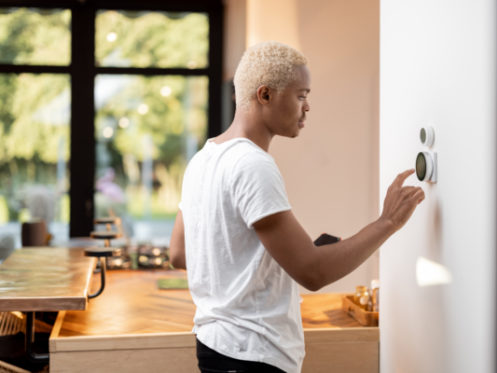You may have fought with other members of your household about what temperature to set the thermostat over the winter. While some may like it warm, you’re concerned about breaking the bank with the heating costs. Is there such a thing as the perfect furnace temperature over the winter? Perhaps not. However, here’s a little information on how to set your thermostat while saving some money.
The EPA’s Recommended 68 Degrees
The EPA looks at household temperatures in terms of energy consumption and the effect on the environment. From this perspective, they posit that the ideal winter temperature is 68 degrees Fahrenheit. This is low enough to keep down fuel consumption. However, it’s also fairly comfortable with layered clothing.
While this makes sense, if you have young children, elderly family members, or sensitive plants or animals in the house, this may not be the right setting for your home. Expand this recommendation to achieve the same result by seeing this as an average temperature recommendation.
You can manage your temperature settings to have it warmer at some times and cooler at others to maintain this average rather than just leaving it at 68 all the time. This allows you to be more comfortable while also saving on your energy expenses.
Considerations for Thermostat Settings
First, consider the people in your home and their individual needs. For instance, the recommendation for babies is a temperature between 68 and 72 degrees.
On the other hand, if you have an indoor garden or houseplants, you’ll want to keep your house between 60 and 75 degrees. Allowing your house to drop below 50 degrees risks damage to your plants.
If you have pets, you’ll want to keep your temperature between 64 and 78 degrees. Of course, it depends on what kind of pets you have and if they have their own heat source, like a reptile in a terrarium or an amphibian or fish in an aquarium.
Finally, consider what temperature will help prevent damage to your home. For instance, if you live in a mobile home, you may need to have a higher temperature setting to keep your pipes from freezing because mobile homes often have less insulation.
What Causes Higher Fuel Consumption?
Your utility costs may skyrocket, despite keeping a low-temperature setting, when there are problems in your system or home. You can classify these into airflow restrictions, mechanical problems, or insulation problems.
The temperature rise for your furnace is consistent, regardless of how much air is moving through. This means that if a restriction in the system reduces airflow, the system has to run longer heating cycles to bring the room temperature up. The unit continues consuming the same amount of fuel during the cycle, so longer cycles translate into more fuel being used.
The same is true for many mechanical failures in the system. The failure may reduce airflow through the system, such as with a failing circulating fan. It could also lower the temperature rise, such as you might see when there is a problem with a regulator, sensor, or burner.
Finally, poor insulation allows too much heat transfer. While this may not mean longer heating cycles, it will mean that your furnace will run more frequently, consuming more fuel to maintain the temperature.
How Programs Allow You to Stay Warmer
Most digital thermostats offer some kind of programming feature. These allow you to adjust your thermostat’s setting based on the time of day to keep you more comfortable. According to the EPA, this also allows you to reduce the strain on your system and conserve fuel for heating.
In fact, according to their estimates, if you adjust your thermostat down by 7 to 10 degrees for eight hours a day, you can save up to about 10% of your heating costs. This also allows you to keep your home a little warmer during waking hours and a little cooler when you won’t notice it.
For instance, you may want to keep your home between 70 and 72 degrees while you’re awake and active. While your home is empty, drop that temperature down to between 60 and 62 degrees. While you’re asleep, set it between 66 and 68 degrees.
Insulation and Ducts
When most people think of insulation for their home, they think of their attic and possibly their doors and windows. These are all important areas to check and make sure that you have sufficiently insulated to prevent heat loss.
However, before the heat can ever get to these areas to leak, you have to consider your ducts. A properly maintained duct system is sealed to prevent air leakage while on its way to the appropriate vent. However, the ducts get warm and transfer some heat to the air in unheated parts of the house.
Prevent this by having your ducts professionally sealed and insulated. This ensures that the air arriving in your rooms is closer to what comes out of the furnace. After all, you want most of the fuel used to actually heat your living space.
Leveraging Your Ceiling Fans
You probably consider your ceiling fan to be part of what keeps you cool in the summer, and rightly so. However, there’s a switch on the side of your fan that reverses how it rotates, which is the winter setting.
A commonly known fact of physics is that hot air rises. What that means for your home is that, as your furnace runs, that hot air rises to the ceiling in your room, well above where you will enjoy it. This phenomenon causes more frequent heating cycles to keep the air temperature at the level of your thermostat at your preferred setting.
By using the winter setting on low, your ceiling fan draws cool air up, forcing the warm air back down. This allows for more heat distribution and makes the temperature of the room feel warmer between heating cycles. It also helps reduce the frequency of heating cycles, reducing your fuel consumption.
HVAC Maintenance and Your Home’s Temperature
You may understand how important maintenance is to keeping your system working. However, it is just as important for maintaining a comfortable temperature in your home.
A clogged air filter, or an airflow restriction at the circulating fan or heat exchanger, causes lower airflow through the system. In turn, this raises the heat retained in your furnace. This extra heat trips your safety sensors, shutting down your furnace to prevent it from overheating.
In your living space, this means that your rooms never reach your ideal temperature, so they always seem cold. It also causes the furnace to cycle on more frequently, constantly trying to achieve your set temperature. The result is consuming more fuel and increasing the frequency of furnace repairs, all while being cold in your home. Prevent all of this by changing your furnace filter regularly and keeping current on your routine maintenance.
Residents of Jacksonville have enjoyed the heating and air conditioning service that Buehler Air Conditioning has brought to the area since 2010. Our NATE-certified technicians provide heating and air conditioning installation, maintenance, and repair and indoor air quality solutions. Call to schedule your heating maintenance or repair with one of our expert technicians today.




